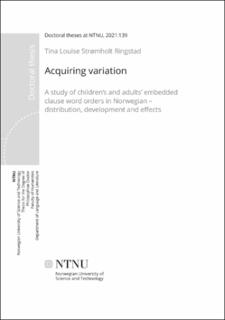| dc.contributor.advisor | Eide, Kristin Melum | |
| dc.contributor.advisor | Westergaard, Marit | |
| dc.contributor.advisor | Kush, Dave | |
| dc.contributor.author | Ringstad, Tina Louise Strømholt | |
| dc.date.accessioned | 2021-08-10T12:03:43Z | |
| dc.date.available | 2021-08-10T12:03:43Z | |
| dc.date.issued | 2021 | |
| dc.identifier.isbn | 978-82-326-6992-9 | |
| dc.identifier.issn | 2703-8084 | |
| dc.identifier.uri | https://hdl.handle.net/11250/2767200 | |
| dc.description.abstract | Sammendrag
Denne avhandlinga undersøker grammatisk variasjon i vaksenspråk og i førstespråkstileigning, altså barns tileigning av morsmålet sitt. Å lære meir om korleis tileigning av variasjon går føre seg kan gi viktige innsikter i korleis mekanismane i den menneskelege språkevna fungerer, og å lære meir om kor variasjon finst i vaksenspråk kan fortelje oss noko om kvifor variasjon finst.
Gjennom tre artiklar og ein kappeartikkel studerer denne avhandlinga ein spesielt eigna type grammatisk variasjon i norsk: Ordfølgd i leddsetningar. I leddsetningar med negasjon (`ikkje’), kan verbet stå etter negasjonen, som i (1), eller verbet kan stå før negasjonen, som i (2). I den første eksempelsetninga står subjektet han før negasjonen, men det kan også stå etter, som i (3).
(1) Han sa [at han ikkje hadde lyst på kake]
(2) Han sa [at han hadde ikkje lyst på kake]
(3) Han sa [at ikkje han hadde lyst på kake]
Studiane i denne avhandlinga utforskar kor, kvifor og korleis denne variasjonen opptrer i talespråket til morsmålsbrukarar av norsk, både vaksne og barn (3-7 år gamle). Ein detaljert gjennomgang av vaksne sin spontantale i korpus syner eit klart system der ordfølgda i (1), negasjon-verb, kan brukast i alle leddsetningar, medan bruken av dei andre variasjonane er avgrensa til spesifikke setningstypar og påverka av typen subjekt. Resultata peiker mot at dei spesielle rekkefølgjene verb-negasjon og negasjon-subjekt blir brukt for å formidle ny informasjon i ein samtale, mens negasjon-verb er ei nøytral rekkefølgje.
Innsamling av elisitert taleproduksjon hos over 30 trønderske barn (per studie) viser at desse barna bruker alle, og berre, dei tre moglege variasjonane allereie frå 3-årsalderen. Funna viser at språktileigningsmekanismen er ekstremt fininnstilt frå ein tidleg alder. Samstundes bruker barn variasjonen litt annleis enn vaksne: Dei to mest sjeldne ordfølgdene, i (2) og (3), er mykje hyppigare brukt. Med andre ord skjer ikkje førstespråkstileigning gjennom frekvensanalyse av ulike variasjonar, men er styrt av barns eigne, midlertidige, reglar for grammatikken til språket dei tileignar seg. I avhandlinga blir resultata analyserte samla per alderstrinn, men også gjennom både eit individ-perspektiv og eit utviklingsperspektiv, og eg foreslår at desse reglane er resultat mellom anna av at barn først har brukt meir tilgjengelege delar av grammatikken som grunnlag for sine språkspesifikke reglar, og at dei utviklar meir sofistikerte grammatiske analysar etterkvart. | en_US |
| dc.description.abstract | Summary
This dissertation investigates grammatical variation in adult language and in first language acquisition. Learning more about how acquisition of variation happens may provide important insights into the mechanisms of the human language faculty, and learning more about where variation exists in adult language can inform us on why it exists. Through three articles and a cover article, this dissertation studies a particularly suited type of grammatical variation in Norwegian: word order in embedded clauses. In embedded clauses with negation (`not’), the verb can follow negation, as in (1), or the verb can precede negation, as in (2). In the first example the subject, he, precedes negation, but it can also follow, as in (3).
(1) He said [that he not wanted cake]
(2) He said [that he wanted not cake]
(3) He said [that not he wanted cake]
The studies in this dissertation explore where, why and how this variation occurs in the spoken language of Norwegian native speakers, both adults and children (aged 3-7 years). A detailed examination of adults’ spontaneous speech in corpora show a clear system where the word order in (1), negation-verb, can be used in all embedded clauses, whereas the use of the other variations is limited to specific clause types and affected by the subject type. The results point towards the `special’ word orders verb-negation and negation-subject being used to introduce new information in a conversation, while negation-verb is a neutral order.
Elicited speech collected from over 30 children (per study) with the Trøndelag dialect shows that they use all, and only, the three possible variations already from age 3. The findings show that the language acquisition device is extremely fine-tuned from an early age. However, children use the variation slightly different than adults: The two most rare word orders, in (2) and (3), are much more frequently used. This points to first language acquisition not happening through frequency analyses of different variations, but being controlled by children’s temporary rules for the grammar of the language being acquired. In the dissertation, the results are analyzed age-wise, but also through both a perspective on individual variation and a developmental perspective. I suggest that these rules result from, amongst other factors, children having used more accessible parts of the grammar as the foundation for their language specific rules, and that they continue to develop more sophisticated grammatical analyses. | en_US |
| dc.language.iso | eng | en_US |
| dc.publisher | NTNU | en_US |
| dc.relation.ispartofseries | Doctoral theses at NTNU;2021:139 | |
| dc.relation.haspart | Paper 1: Ringstad, Tina Louise. Distribution and function of embedded V–Neg in Norwegian: A corpus study. Nordic Journal of Linguistics 2019 ;Volum 42. s. 329-363 https://doi.org/10.1017/S0332586519000210 | en_US |
| dc.relation.haspart | Paper 2:
Ringstad, Tina L.; Kush,Dave.
Learning Embedded Verb Placement in Norwegian: Evidence for early overgeneralization. | en_US |
| dc.relation.haspart | Paper 3:
Ringstad, Tina L.; Westergaard, Marit.
Children’s acquisition of word order variation: A study of subject placement in embedded clauses in Norwegian. | en_US |
| dc.title | Acquiring variation: A study of children’s and adults’ embedded clause word orders in Norwegian – distribution, development and effects | en_US |
| dc.type | Doctoral thesis | en_US |
| dc.subject.nsi | VDP::Humanities: 000::Literary disciplines: 040 | en_US |

